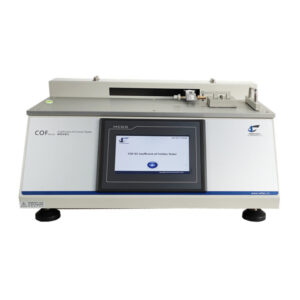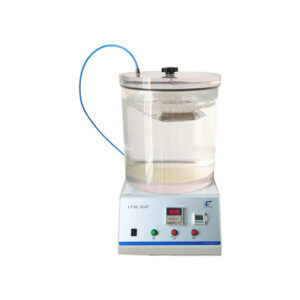耐加水分解性ガラス粒子サンプラー GHR-01A の紹介
の GHR-01A 耐加水分解性ガラス粒子サンプラー は、水に対するガラス材料の化学的安定性を評価するために設計された高度な機器です。この重要な品質管理テストは、ガラス瓶やアンプルなどの包装材料がその中に入っている薬剤とどのように相互作用するかを判断し、これらの製品の安定性と安全性に直接影響を与えるため、製薬業界では不可欠です。
耐加水分解性試験の理解
耐加水分解性試験は、ガラス材料が水と接触したときに劣化する傾向を評価します。この劣化によりイオンが放出され、医薬品の効能が損なわれる可能性があります。ガラス包装が高い耐加水分解性を示すようにすることは、医薬品の完全性を維持し、副作用を防ぐために不可欠です。
耐加水分解性試験の基準
- ISO719 規格: ガラス – 98℃におけるガラス粒子の耐加水分解性
この規格は、98℃の温度でのガラス粒子の耐加水分解性を評価するための試験方法と分類を概説しています。サンプルの準備方法と耐水性の評価方法に関するガイドラインを提供します。これは、一般的な保管条件下でガラス包装の完全性を維持するために不可欠です。 - ISO720 規格: ガラス – 121℃におけるガラス粒子の耐加水分解性
類似 ISO719 規格この規格は、121℃の高温でガラス粒子を試験することに重点を置いています。この規格は、特に滅菌プロセスに関連する、より過酷な条件下でガラス材料がどのように機能するかを評価するための厳密な方法論を提供します。
テスト方法
試験プロセスでは、ガラスサンプルを乳鉢に入れ、自動乳棒が下降してガラスを破片に砕きます。次に、この装置が一連のふるいを振動させ、適格サンプルをガラス粒子廃棄物から分離します。この自動化されたアプローチにより、サンプルは ISO 719 および ISO 720 で規定された基準に従って正確かつ効率的に準備されます。
GHR-01Aテスターの機能と利点
- スマートオートメーションGHR-01A は、粉砕と振動ふるい分けを 1 つのユニットに統合し、シームレスなサンプル準備を容易にし、標準に準拠したサンプル サイズを保証します。
- ユーザーフレンドリーなインターフェースHMI 画面の操作により、人間と機械のやり取りが簡単になり、オペレーターがテスト プロセスを簡単に管理できるようになります。
- 安全機能: 手作業の削減により作業員の安全性が向上し、内蔵の安全装置がガラスの飛散を防ぎ、テストの完全性を維持します。
- 環境に優しいデザイン: この装置には、環境への影響を最小限に抑えるための特殊なガラス廃棄物収集機能が含まれています。
- 精密テスト: 自動ふるい分けにより精度が向上し、信頼性の高い結果が得られます。
- リミットスイッチ機能: 追加された安全対策により、操作上の危険を防止します。
- 最適化された設計: 垂直レイアウトにより、大きなサンプルに対する重力の影響が軽減され、一貫したテスト結果が保証されます。
主なパラメータ
| 乳鉢/乳棒の寸法 | Φ50/Φ48mm |
| ふるいAの開口部 | 425μm |
| ふるいBの開口部 | 300μm |
| ふるいO開口部 | 600μmμm |
| ふるい振盪時間 | 5分 |
| ガス圧 | 0.5 MPa |
| ガスポートサイズ | Ф6mm |
| 力 | AC110~220V 50Hz |
GHR-01Aテスターの用途
GHR-01A は、特に製薬業界や医療機器業界での幅広い用途に不可欠です。輸液ボトル、注射ボトル、アンプル、経口液ボトルなど、さまざまな医療用ガラス製品に使用されるガラス粒子の耐加水分解性サンプルを準備するのに最適です。
要約すると、 GHR-01A ガラス粒子耐加水分解性試験機 は、医薬品用ガラス包装の品質と安全性を確保するための高度なソリューションです。この機器は、ISO 規格に準拠しており、医薬品の完全性を維持するために不可欠な信頼性の高い結果を提供します。最高水準の品質管理を確保するために、テストのニーズに合わせて GHR-01A を選択してください。
よくある質問
- 耐加水分解性とは何ですか? 耐加水分解性とは、水にさらされたときにガラス材料が劣化に抵抗する能力を指し、医薬品の安定性を維持するために重要です。
- GHR-01A テスターはどのように動作しますか? テスターはガラスサンプルを自動的に粉砕し、ふるいを振動させて適合粒子を廃棄物から分離し、テストプロセスを合理化します。
- GHR-01A はどのような規格に準拠していますか? GHR-01A は、ガラス粒子の耐加水分解性試験に関する ISO 719 および ISO 720 規格に準拠しています。
- どのような種類の製品をテストできますか? GHR-01A は、輸液ボトル、注射ボトル、アンプル、経口液容器などに使用されるガラスの試験に適しています。
- テストプロセスは安全ですか? はい、GHR-01A は、人員を保護し、テストの整合性を維持するための複数の安全機能を備えて設計されています。





